Teleport Authentication with Google Workspace (G Suite)
This guide explains how to configure Google Workspace to be a single sign-on (SSO) provider that issues Teleport credentials to specific groups of users. When you use Google Workspace in combination with Teleport role-based access control (RBAC), you can define policies like the following:
- Only members of the "DBA" Google group can connect to PostgreSQL databases.
- Developers must never use SSH to access production servers.
Prerequisites
Before you get started, verify the following:
-
You have a Google Workspace super administrator account. As a best practice, you should set up a separate account that requires multifactor authentication to perform administrative actions. In most cases, you should avoid granting your own sign-in user account elevated administrative privileges.
-
You can sign up for Google Cloud and create a Google Cloud project. Note that this guide doesn't require using any paid Google Cloud services.
-
You can set up Google Workspace groups.
-
You have a Teleport role with permission to maintain
oidcresources. This permission is available in the preseteditorrole. -
You have a Teleport cluster, Enterprise edition, and command-line tools.
-
A running Teleport cluster. If you want to get started with Teleport, sign up for a free trial.
-
The
tctladmin tool andtshclient tool.Visit Installation for instructions on downloading
tctlandtsh.
-
-
To check that you can connect to your Teleport cluster, sign in with
tsh login, then verify that you can runtctlcommands using your current credentials.For example:
$ tsh login --proxy=teleport.example.com [email protected]
$ tctl status
# Cluster teleport.example.com
# Version 16.4.7
# CA pin sha256:abdc1245efgh5678abdc1245efgh5678abdc1245efgh5678abdc1245efgh5678If you can connect to the cluster and run the
tctl statuscommand, you can use your current credentials to run subsequenttctlcommands from your workstation. If you host your own Teleport cluster, you can also runtctlcommands on the computer that hosts the Teleport Auth Service for full permissions.
Step 1/4. Configure Google Workspace
The following steps are required to configure Google Workspace to work with Teleport:
- Review your Google Workspace edition to determine how it integrates with Teleport.
- Create a new project on the Google Cloud Platform.
- Configure OAuth consent for the new project.
- Enable the required APIs.
- Create an OAuth client ID to allow Google Workspace users to log in to your Teleport cluster.
- Create a service account for Teleport to access additional Google Groups information.
- Configure domain-wide delegation for the service account.
Review your Google Workspace edition
Google Workspace is available in multiple editions with different features and capabilities for individuals and organizations. Because of differences between Google Workspace editions, there are fundamental differences in how Teleport integrates with Google Workspace depending on the Google Workspace edition you use.
Some editions of Google Workspace provide transitive group membership. With transitive group membership, a user can be a member of one group by virtue of being in another group. For example, if there is a child group nested within a parent group, every member of the child group is also a member of the parent group. Teleport can support both direct group membership and transitive group membership, but does so using different methods.
Google Workspace editions and API
Google Workspace service accounts can determine whether a user has a transitive membership in a specific group by calling methods in the Google Workspace Cloud Identity API. These API methods are only usable for users belonging to specific Google Workspace editions.
The Google Workspace Directory API allows administrators to list users and groups in their Google Workspace domain, but does not enable them to query transitive group memberships. The Directory API is available for all Google Workspace editions.
How Teleport uses Google Workspace APIs
The Teleport OIDC connector uses the Google Workspace APIs to map Google Workspace group members to the Teleport roles they belong to.
To list a user's Google Workspace groups, Teleport first attempts to get credentials by calling Cloud Identity API methods. If successful, Teleport uses the credentials to query a user's transitive group memberships.
If the credentials don't exist, Teleport gets credentials by calling Directory API methods. Teleport then uses the Directory API to list the user's groups in the entire Google Workspace for your organization. Groups that the user belongs to that are external to the workspace aren't listed.
How to check your current edition
To determine whether your Google Workspace edition supports querying transitive group memberships:
-
Open Inspect Groups in the Google Workspace Admin Console.
Group inspection relies on the Cloud Identity API.
-
Select List all groups for a member and Include external groups.
If your Google Workspace edition supports the Cloud Identity API, you should block access to external groups at the workspace level as described in Allow or block access to external groups. Otherwise, membership in any group external to the workspace will prevent users from signing in.
If your Google Workspace edition doesn't support the Cloud Identity API, you must ensure that your role-based access controls don't depend on transitive group memberships.
Create a new project
If you want to add single sign-on for Teleport to an existing Google Cloud project, you can select that project in the Google Cloud console and skip this step. If you don't have a project or want to create a new project specifically for Teleport, you can go directly to the Enabled APIs & Service project selector dashboard to create one.
To create a new project:
-
Open the Google Cloud console.
-
In the Google Cloud console navigation menu, click APIs & Services.
-
In Enabled APIs and services, click the project selector, then click New Project. If there are no projects to select in the dashboard, click Create Project.

-
Type a Project name and select an organization and a location for the project, then click Create.
Configure OAuth consent
To configure OAuth consent for the new project:
-
In the Google Cloud console sidebar, click OAuth consent screen.
-
Select Internal as the User Type, then click Create.
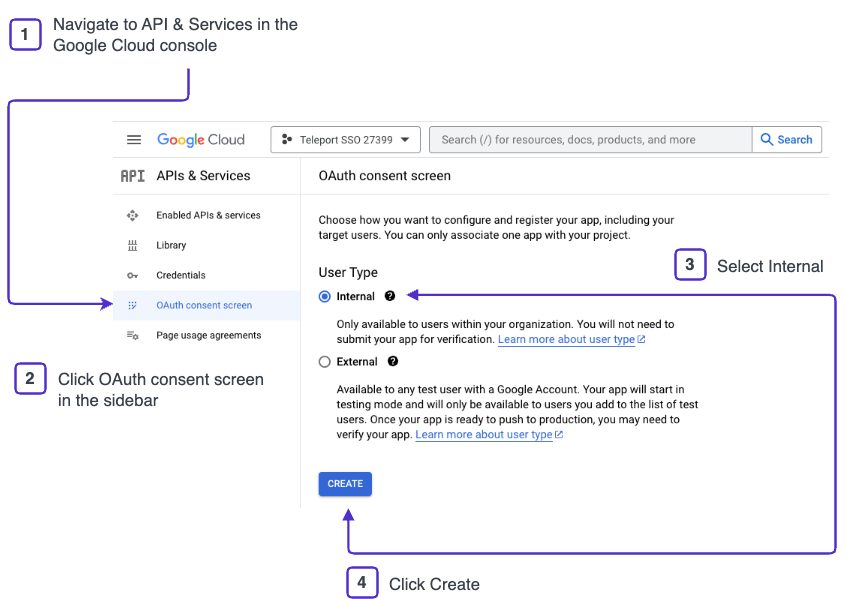
-
Configure the OAuth client consent information by doing the following:
- Type an application name.
- Select a user or group to receive email messages from users about their OAuth consent.
- Set other application options, as needed.
- Provide the email address of the developer to contact if there are changes to the project.
-
Click Save and continue.
-
Click Add or remove scopes.
-
Select .../auth/userinfo.email and openid scopes, then click Update.
-
Click Save and continue.
-
Review the information on the Summary page, then click Back to dashboard.
Enable the required APIs
To enable required APIs for the OAuth client:
- Select Admin SDK API in the API Library, then click Enable to support direct group membership.
- Select Cloud Identity API in the API Library, then click Enable to support transitive group membership.
You can enable one or both API libraries. However, your Google Workspace edition must support the API you choose to use. Consult the documentation for the API library to ensure that you have a supported Google Workspace edition.
Create an OAuth client ID
To create an OAuth client identifier:
-
In the Google Cloud console sidebar, click APIs & Services.
-
In the APIs & Services sidebar, click Credentials.
-
Click Create credentials to display a list of the credentials you can create.
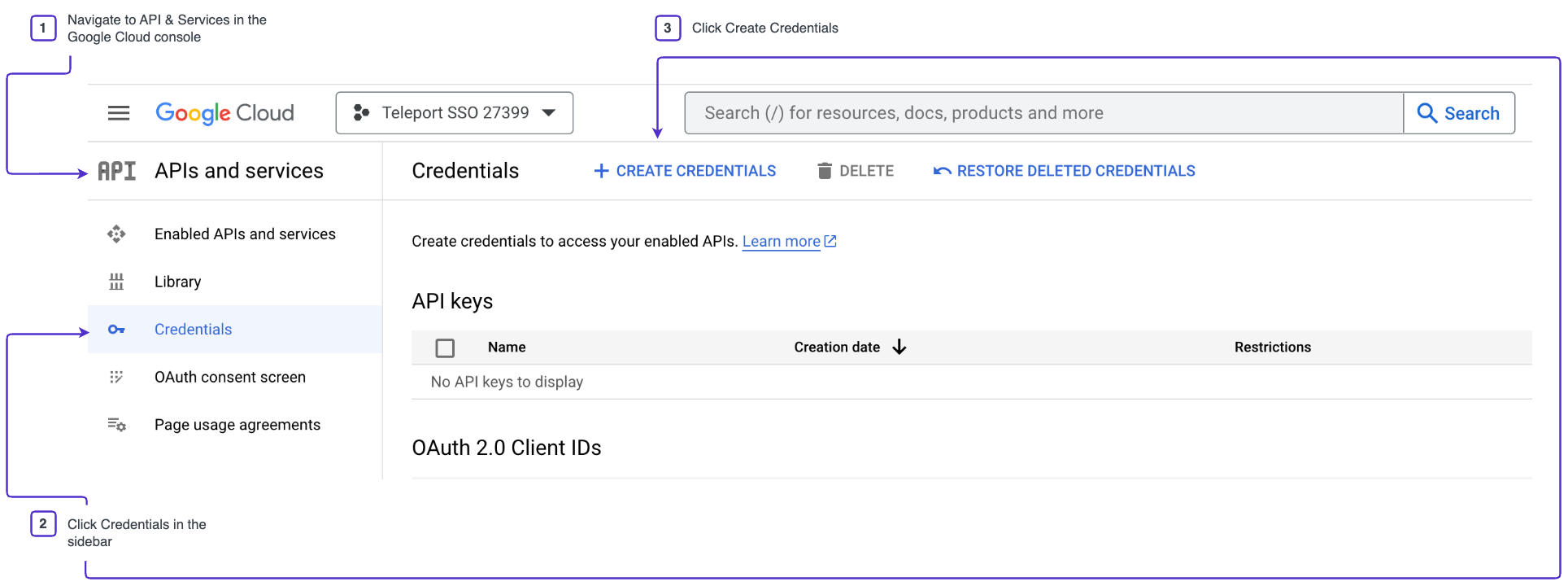
-
Select OAuth client ID.
-
Select Web application as the Application type, and type a name for the application.
-
Under Authorized redirect URIs, click Add URI.
-
Set the redirect URI to the address of your Teleport cluster, then add
/v1/webapi/oidc/callbackto the URI.
-
Click Create.
-
Copy the Client ID and Client secret from the OAuth client created or click Download JSON to save this information, then click OK.
If you choose to save the client identifier and client secret by clicking Download JSON, be aware that this JSON file isn't the one used to handle the credentials for authentication. A second JSON file is generated when you create the service account for the OAuth client.
For example:
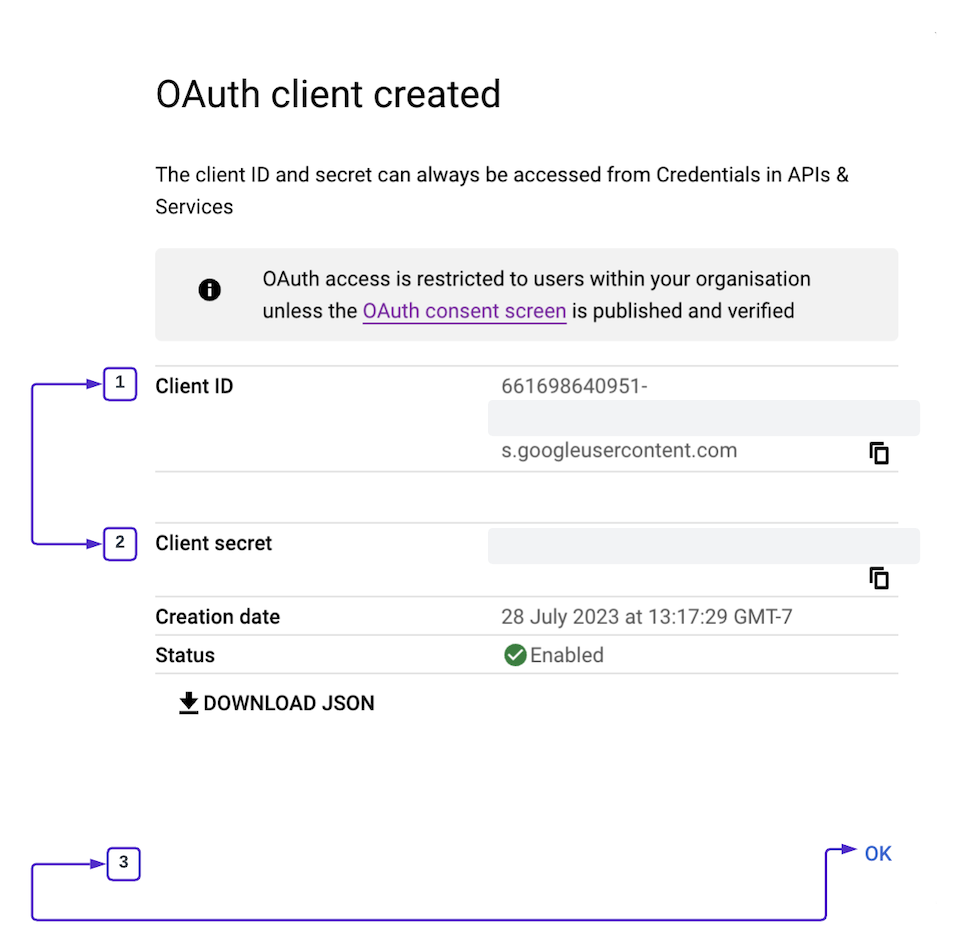
Create a service account
To create a service account:
-
In the Google Cloud console sidebar, click IAM & admin, then select Service Accounts.
-
Click Create service account.
-
Type a name for your service account and, optionally, a description of what the service account is for.
-
Click Create and continue, then click Done.
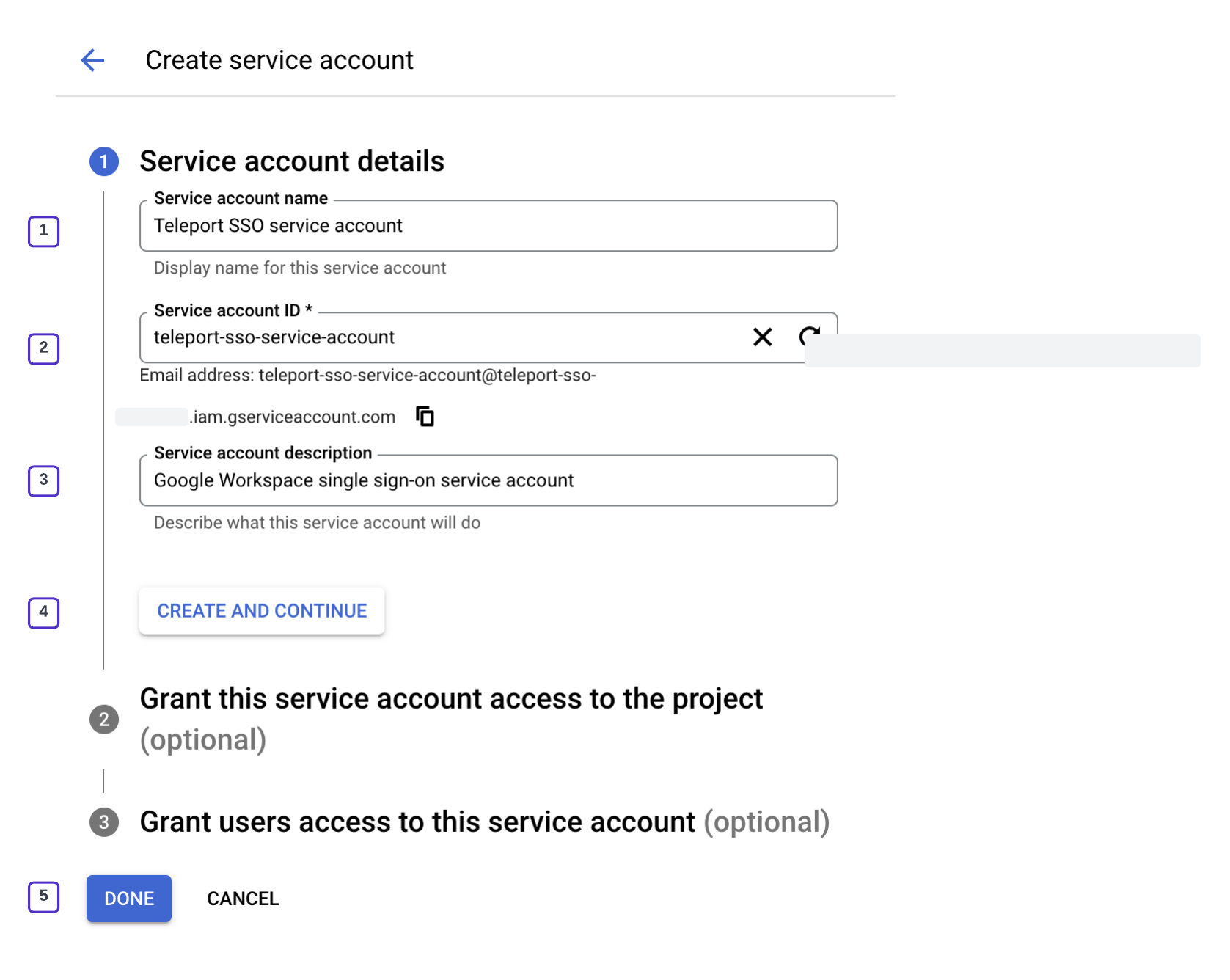
After you click Done, the new service account is added to the list of service accounts for the current project. You can click the newly-created account to view its details and to edit information for the account.
-
Click the new service account to displays its Details, and copy its Unique ID for later.
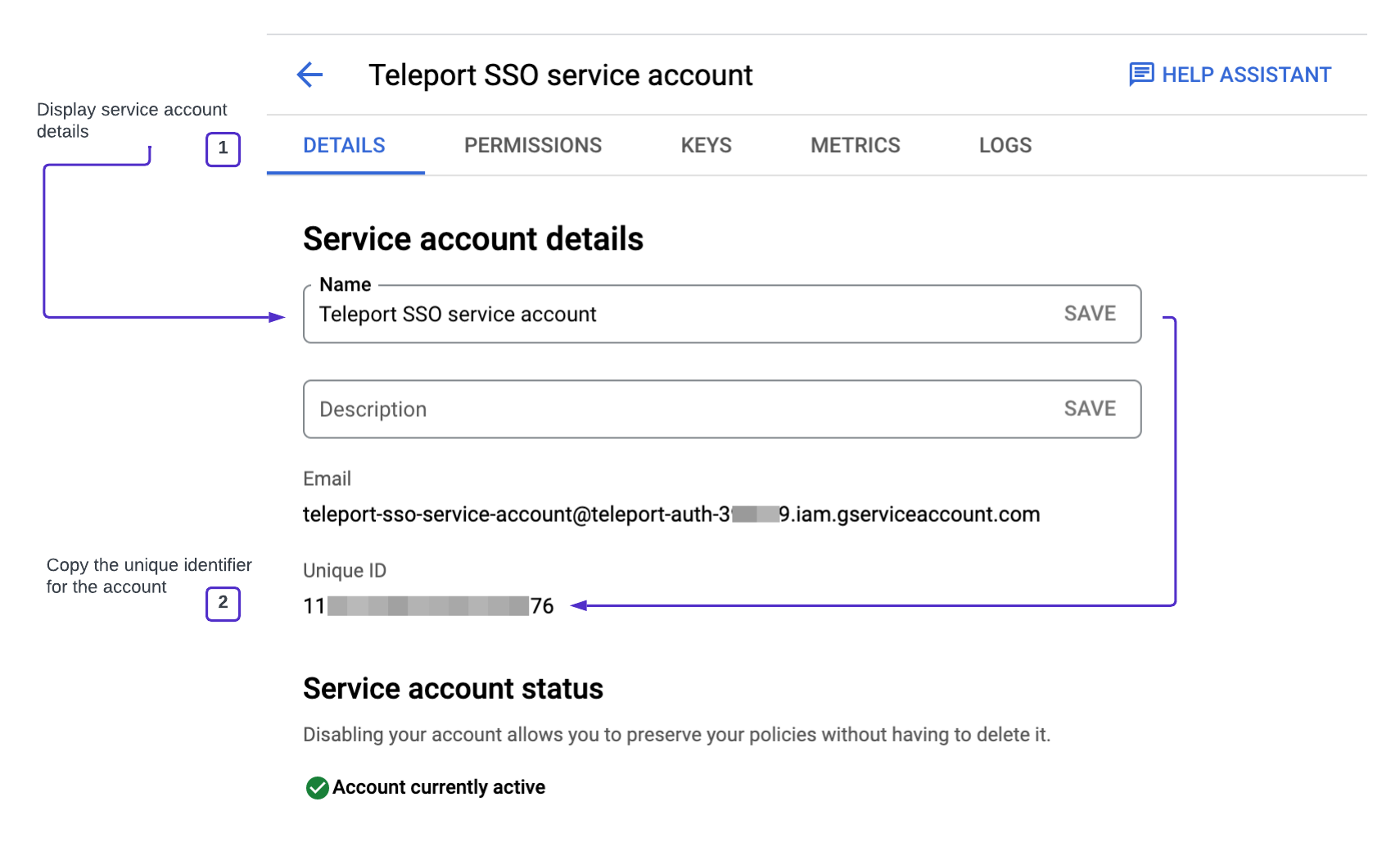
-
Click Keys, click Add key, and select Create new key to create keys for the service account.
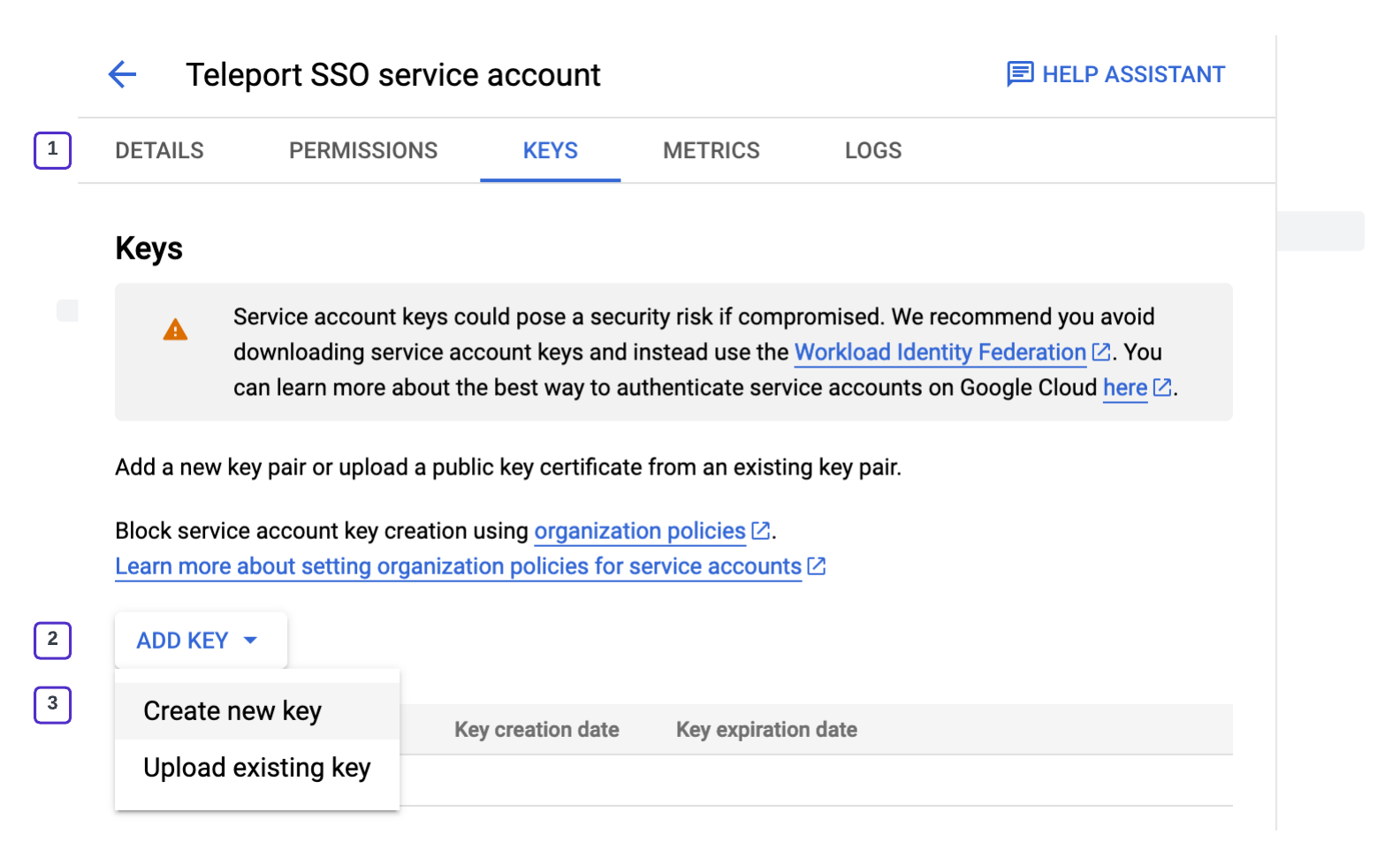
-
Select JSON as the Key type, then click Create.
Google Cloud automatically downloads a JSON file with the keys for the service account similar to the following:
{
"type": "service_account",
"project_id": "teleport-project-xxxxxx",
"private_key_id": "f06e000000000000000dc18",
"private_key": "-----BEGIN PRIVATE KEY-----\n0000000000000w==\n-----END PRIVATE KEY-----\n",
"client_email": "[email protected]",
"client_id": "11xxxxxxxxxxxxx76",
"auth_uri": "https://accounts.google.com/o/oauth2/auth",
"token_uri": "https://oauth2.googleapis.com/token",
"auth_provider_x509_cert_url": "https://www.googleapis.com/oauth2/v1/certs",
"client_x509_cert_url": "https://www.googleapis.com/robot/v1/metadata/x509/gwsso%40teleport-project-xxxxxx.iam.gserviceaccount.com",
"universe_domain": "googleapis.com"
}This file is used to configure the OIDC connector for the Teleport Auth Service to use, either by referencing a local file on the host running the Teleport Auth Service or including the contents in the command line to create the connector resource.
Configure domain-wide delegation
Now that you have a service account for Teleport to use, you can configure domain-wide delegation for the service account.
To configure delegation:
-
Open the Google Workspace Admin console and navigate to Manage domain-wide delegation.
-
Click Add new.
-
Paste the numeric Unique ID that you copied from the service account.
-
Add one of the following scopes depending on your Google Workspace edition:
- For direct groups only, add:
https://www.googleapis.com/auth/admin.directory.group.readonly - For direct and transitive group membership support, add:
https://www.googleapis.com/auth/cloud-identity.groups.readonly
- For direct groups only, add:
-
Click Authorize.
Step 2/4. Create an OIDC connector
After you have prepared Google Workspace, you can create the OIDC connector by
running the tctl sso configure oidc command. Depending on how you have deployed
your Teleport cluster, you can create the OIDC connector resource in one of two ways:
- You can embed the service account information in the connector resource.
- You can upload the service account JSON file to hosts running the Teleport Auth Service.
The service account JSON must be available to all Teleport Auth Service hosts if you deploy Teleport as a high availability cluster. In most cases, you should use the embedded JSON method to create the connector in high availability and cloud deployments to avoid storing credentials in a file on multiple servers.
The alternative to creating the OIDC connector with embedded JSON is to upload the JSON file. If you have a self-hosted Teleport cluster, you can upload the service account JSON file to all hosts running the Teleport Auth Service.
On your workstation, create a file called client-secret.txt consisting only of
your client secret.
- Embed JSON
- Upload JSON
The following command defines the service account by embedding JSON in the command used to create the connector resource. With this method, you don't have to provide the JSON file to all of the hosts running the Teleport Auth Service.
$ tctl sso configure oidc --preset google --id <CLIENT-ID> \
--secret $( cat client-secret.txt) \
--claims-to-roles groups,[email protected],auditor \
--claims-to-roles groups,[email protected],access \
--google-admin=<GOOGLE-WORKSPACE-ADMIN-EMAIL> \
--google-acc '
{
"type": "service_account",
"project_id": <GOOGLE-PROJECT-ID>,
"private_key_id": <GOOGLE-PRIVATE-KEY-ID>,
"private_key": "-----BEGIN PRIVATE KEY-----\n0000000000000w==\n-----END PRIVATE KEY-----\n",
"client_email": <GOOGLE-SERVICE-ACCOUNT-EMAIL>,
"client_id": <GOOGLE-SERVICE-ACCOUNT-UNIQUE-ID>,
"auth_uri": "https://accounts.google.com/o/oauth2/auth",
"token_uri": "https://oauth2.googleapis.com/token",
"auth_provider_x509_cert_url": "https://www.googleapis.com/oauth2/v1/certs",
"client_x509_cert_url": "https://www.googleapis.com/robot/v1/metadata/x509/gwsso%40teleport-project-xxxxxx.iam.gserviceaccount.com",
"universe_domain": "googleapis.com"
}'
After copying this command, be sure to remove the brackets (< >) and replace the placeholder strings with the
appropriate information for your Google Workspace. For example, replace <GOOGLE-WORKSPACE-ADMIN-EMAIL> with
the email address for the domain administrator similar to [email protected].
This command creates a file similar to the following:
kind: oidc
metadata:
name: google
spec:
claims_to_roles:
- claim: groups
roles:
- auditor
value: [email protected]
- claim: groups
roles:
- access
value: teleport-[email protected]
client_id: <CLIENT-ID>
client_secret: <CLIENT-SECRET>
display: Google
google_admin_email: <GOOGLE-WORKSPACE-ADMIN-EMAIL>
google_service_account: |2-
{
"type": "service_account",
"project_id": <GOOGLE-CLOUD-PROJECT-ID>,
"private_key_id": <GOOGLE-SERVICE-ACCOUNT-PRIVATE-KEY-ID>,
"private_key": "-----BEGIN PRIVATE KEY-----\n0000000000000w==\n-----END PRIVATE KEY-----\n",
"client_email": <GOOGLE-SERVICE-ACCOUNT-EMAIL>,
"client_id": <GOOGLE-SERVICE-ACCOUNT-UNIQUE-ID>,
"auth_uri": "https://accounts.google.com/o/oauth2/auth",
"token_uri": "https://oauth2.googleapis.com/token",
"auth_provider_x509_cert_url": "https://www.googleapis.com/oauth2/v1/certs",
"client_x509_cert_url": "https://www.googleapis.com/robot/v1/metadata/x509/gwsso%40teleport-project-xxxxxx.iam.gserviceaccount.com",
"universe_domain": "googleapis.com"
}
issuer_url: https://accounts.google.com
redirect_url: https://example.teleport.sh:443/v1/webapi/oidc/callback
version: v3
The following command specifies the path to the JSON file on a host running the Teleport Auth Service. You can use this method for self-hosted Teleport Auth Service instances if you can make the JSON file available to all hosts running the Teleport Auth Service.
$ tctl sso configure oidc --preset google --id <CLIENT-ID> \
--secret $( cat client-secret.txt) \
--google-acc-uri <PATH/TO/SERVICE-ACCOUNT-KEY>.json \
--claims-to-roles groups,[email protected],auditor \
--claims-to-roles groups,[email protected],access \
--google-admin=<GOOGLE-WORKSPACE-ADMIN-EMAIL> > gworkspace-connector.yaml
After copying this command, be sure to remove the brackets (< >) and replace the placeholder strings with the
appropriate information for your Google Workspace. For example, replace <GOOGLE-WORKSPACE-ADMIN-EMAIL> with
the email address for the domain administrator similar to [email protected].
This command creates a file similar to the following:
kind: oidc
metadata:
name: google
spec:
claims_to_roles:
- claim: groups
roles:
- auditor
value: [email protected]
- claim: groups
roles:
- access
value: teleport-[email protected]
client_id: <CLIENT-ID>
client_secret: <CLIENT-SECRET>
display: Google
google_admin_email: <GOOGLE-WORKSPACE-ADMIN-EMAIL>
google_service_account_uri: </PATH-TO-SERVICE-ACCOUNT-KEY>.json
issuer_url: https://accounts.google.com
redirect_url: https://teleport.example.com/v1/webapi/oidc/callback
version: v3
The email that you set for google_admin_email must be the email address of
an account that has permission to list all groups, users, and group membership in
Google Workspace. In general, this user account must have full administrative privileges
or group administrative privileges.
Don't use the email of the service account for google_admin_email. The
configuration might look the same, but the service account doesn't have
the required domain-wide delegation.
The client_id field must be the unique numeric ID for the service account that you created
for the OAuth client in the Google Cloud console. You can check whether this setting is configured
correctly by viewing the audit logs on the host running the Teleport Auth Service or from
the Management tab in the Teleport Web UI. If you see "invalid Google Workspace
credentials for scopes [...]" in audit log messages, change the client_id setting in the
resource configuration file. For more information about viewing audit logs, see
Troubleshooting.
To test the connector, run the following command:
$ cat gworkspace-connector.yaml | tctl sso test
This command opens the browser and attempts to sign you in to your Teleport cluster using Google. If it fails, review the command output for troubleshooting information.
To create the connector using the tctl tool, run the following command:
$ tctl create -f gworkspace-connector.yaml
Step 3/4. Test your Google Workspace OIDC connector
After you create the connector, the Teleport Web UI displays a new sign-in option, Login with Google. To sign in from the command-line:
$ tsh --proxy=proxy.example.com login --auth=google
This command displays the single sign-on endpoint URL and tries to open it automatically in a browser.
Step 4/4. Enable default OIDC authentication
Configure Teleport to use OIDC authentication as the default instead of the local user database.
Edit your cluster_auth_preference resource:
$ tctl edit cap
In your editor, ensure that the file contains the following content:
kind: cluster_auth_preference
metadata:
name: cluster-auth-preference
spec:
type: oidc
version: v2
Troubleshooting
Troubleshooting SSO configuration can be challenging. Usually a Teleport administrator must be able to:
- Be able to see what SAML/OIDC claims and values are getting exported and passed by the SSO provider to Teleport.
- Be able to see how Teleport maps the received claims to role mappings as defined in the connector.
- For self-hosted Teleport Enterprise clusters, ensure that HTTP/TLS certificates are configured properly for both the Teleport Proxy Service and the SSO provider.
If something is not working, we recommend to:
- Double-check the host names, tokens and TCP ports in a connector definition.
Using the Web UI
If you get "access denied" or other login errors, the number one place to check is the Audit Log. Under the Management area you can access it within the Activity tab in the Teleport Web UI.
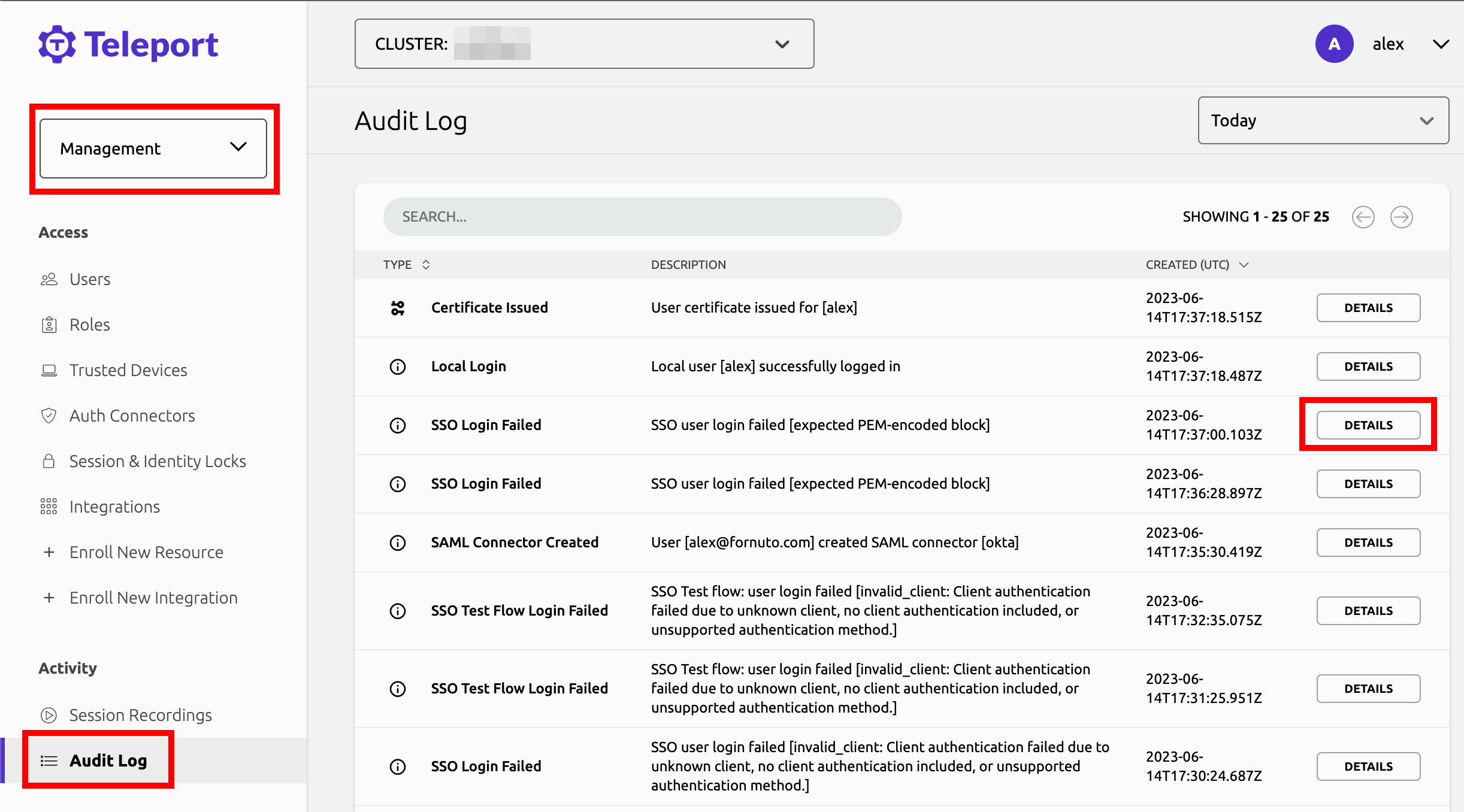
Example of a user being denied because the role clusteradmin wasn't set up:
{
"code": "T1001W",
"error": "role clusteradmin is not found",
"event": "user.login",
"method": "oidc",
"success": false,
"time": "2019-06-15T19:38:07Z",
"uid": "cd9e45d0-b68c-43c3-87cf-73c4e0ec37e9"
}
Teleport does not show the expected Nodes
When Teleport's Auth Service receives a request to list Teleport Nodes (e.g., to
display Nodes in the Web UI or via tsh ls), it only returns the Nodes that the
current user is authorized to view.
For each Node in the user's Teleport cluster, the Auth Service applies the following checks in order and, if one check fails, hides the Node from the user:
- None of the user's roles contain a
denyrule that matches the Node's labels. - At least one of the user's roles contains an
allowrule that matches the Node's labels.
If you are not seeing Nodes when expected, make sure that your user's roles
include the appropriate allow and deny rules as documented in the
Teleport Access Controls Reference.
When configuring SSO, ensure that the identity provider is populating each user's
traits correctly. For a user to see a Node in Teleport, the result of populating a
template variable in a role's allow.logins must match at least one of a user's
traits.logins.
In this example a user will have usernames ubuntu, debian and usernames from the SSO trait logins for Nodes that have a env: dev label. If the SSO trait username is bob then the usernames would include ubuntu, debian, and bob.
kind: role
metadata:
name: example-role
spec:
allow:
logins: ['{{external.logins}}', ubuntu, debian]
node_labels:
'env': 'dev'
version: v5
Single sign-on fails with OIDC
When encountering the error message "Failed to verify JWT: oidc: unable to verify JWT signature: no matching keys", it typically indicates a discrepancy between the algorithm used to sign the JWT token and the algorithm(s) supported by the JSON Web Key Set (JWKS). Specifically, the token might be signed with one algorithm, e.g., HS256, while the JWKS only lists keys for a different algorithm. e.g., RS256. This issue predominantly arises when using identity providers that offer extremely low-level functionality.
Here are some things to check:
- Verify the JWT header specifies the correct signing algorithm. This should match one of the algorithms listed in the keys section of the JWKS endpoint response.
- Ensure the JWKS endpoint is returning all relevant public keys. Sometimes key rotation can cause valid keys to be omitted.
To resolve the issue, align the JWT algorithm header with a supported algorithm in the JWKS. Rotate keys if necessary. Verify the JWKS only publishes the active public keys. With proper configuration, the signature should validate successfully.